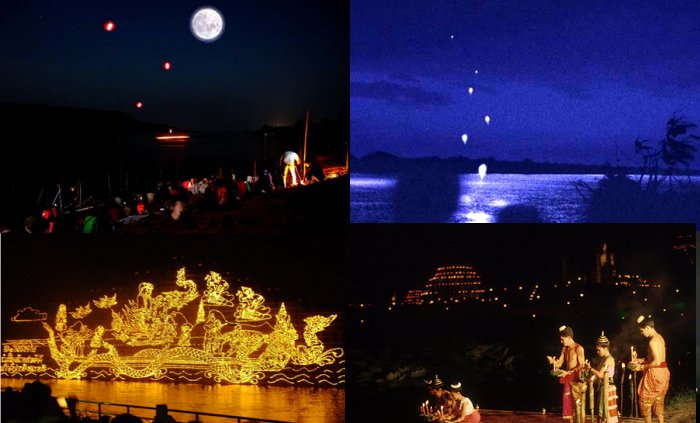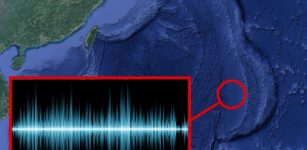Mystery Of The Naga Fireballs At Mekong River
Cynthia McKanzie – MessageToEagle.com – The mysterious Naga fireballs visible at Mekong River in Thailand have captured the interest of locals and scientists for a long time. Occurring often in the cool nights in late October and early November, the Naga Fireballs are mysterious glowing balls of bright red light that explode from the muddy waters of Mekong River.
Locals are convinced the lights are of supernatural origin and call the phenomena the Mekong Lights or Naga Dancing Fireballs (“bung fai paya nak”). Scientists have been puzzled by the Naga fireballs, but they offer a more down-to earth explanation what could be causing the explosions from the river.
Thousands of fireballs are visible once a year
The Naga fireballs have been witnessed by thousands of people. Each year, thousands of red glowing orbs shoot from the water quickly and rise silently to around 600 feet in the air before disappearing. The number of fireballs reported varies between tens and thousands each year.

One American who traveled to Nong Khai to witness the lights during the annual Naga Fireball Festival wrote:
“I went to Nong Khai and Phon Phisai where the spectacular Naga light fireball festival was in full swing on the Mekong river looking towards Laos. I was in Phon Phisai on Saturday night October 7 for the anticipated fireball display. The human part of the light show – fireworks, rockets, large fire balloons, fireboats etc – was in great evidence, but when the Naga fireballs started emerging, they were strikingly different to the easily discernible human displays – very straight vertical flights out of river to a great height and then disappearing after a few seconds. Each appearance was greeted with a huge roar from the thousands of people lining the river at every vantage point along the Mekong.”
Legend tells the fireballs come from the breath of Phaya Naga
The fireballs appear very often on the late autumn night of the full moon at the end of the Buddhist Lent for as long as anyone can remember. In modern day Thailand, the celebration involves huge gatherings of people on the bank of the river, all to watch the fireballs rise and disappear in the heavens. The celebration commemorates the return of Buddha in Naga form. It is widely believed by Buddhists and others that the Naga Fireballs are actually the breath of a giant sea serpent, a Naga or Phaya Naga that lives in the riverbed and awakes every year at this time to honor the conclusion of vassa (The three month long season of Rain Retreat or Buddhist Lent).

In Hinduism, Buddhism, and Jainism, Nagas are described as shape-shifters. They can appear entirely in human form, as serpents or half-human and half-serpent.
In Thailand and Java, the Naga is a wealthy underworld deity. In Laos they are beaked water serpents. Nagas are believed to reside live in an underground kingdom called Naga-loka, or Patala-loka, which is filled with resplendent palaces, beautifully ornamented with precious gems. They are also associated with waters -rivers, lakes, seas, and wells, and are guardians of treasure.

In Thailand, the Nagas are regarded as protectors of Vientaine (the capital of Laos) and by extension, Laos State, but they are revered by most in the Makong river area of Thailand as powerful magical beasts.
How can science explain the Naga fireballs phenomenon?
One explanation for the Naga Fireballs is that swamp gas which is formed as organic material decomposes underground producing pockets of methane. The methane eventually finds its way to the surface, and upon contacting oxygen-rich air, spontaneously ignites producing a brief burst of flaming gaseous bubbles.
Dr. Manos Kanoksilp who studied the Naga fireballs theorizes that the phenomenon requires a precise alignment of the sun, moon and Earth, and that the Mekong river provides a perfect storm of conditions to bring about the fireballs every year at the same time.

See also:
Unusual And Eerie Green Lights Haunting The Woods – The “Foxfire” Phenomenon!
Spectacular Reed Flute Cave With Multicolored Lighting Admired By Millions
Fly Ranch Geyser: Nevada’s Marvellous And Unique Oddity
Similar to the swamp gas theory, some believe the Naga lights are flammable phosphine gas generated by the river’s marshy environment. Thai Science Ministry’s Deputy Secretary Saksit Tridech and a team of scientists used special equipment to measure conditions around the river and proclaimed that the fireballs were the result of built-up phosphine gas.
Phosphine is manufactured for industrial purposes through a carefully orchestrated chemical process. However, it for now, it remains unclear how this process could be generated in nature. Similar to methane, it is theorized to be the product from bacterial reduction of phosphate in decomposing organic material.
There are also scientists who suggest that the Naga Fireballs are a type of free-forming plasma orb, created when surface electricity is discharged in the river’s waters.
For now, we simply don’t know what’s behind the Naga fireballs phenomenon, but it certainly does not prevent visitors from admiring this wonderful light show once a year.
Written by Cynthia McKanzie – MessageToEagle.com Staff Writer
Copyright © MessageToEagle.com. All rights reserved. This material may not be published, broadcast, rewritten or redistributed in whole or part without the express written permission of MessageToEagle.com
Related Posts
-
 The Word ‘Scientist’ First Appeared In 1833
No Comments | May 1, 2016
The Word ‘Scientist’ First Appeared In 1833
No Comments | May 1, 2016 -
 Reincarnation – Journey Of The Souls And Our Karma We Depend On In The Next Life
No Comments | Aug 2, 2018
Reincarnation – Journey Of The Souls And Our Karma We Depend On In The Next Life
No Comments | Aug 2, 2018 -
 New York Was Once Called New Amsterdam – History Behind The Change Of Name
No Comments | Jan 14, 2017
New York Was Once Called New Amsterdam – History Behind The Change Of Name
No Comments | Jan 14, 2017 -
 Mysterious Loud Booms Heard World-Wide This Year Still Remain Unexplained
No Comments | Nov 27, 2017
Mysterious Loud Booms Heard World-Wide This Year Still Remain Unexplained
No Comments | Nov 27, 2017 -
 Parallel Universes May Be Hidden Inside Supermassive Black Holes
No Comments | Jul 24, 2017
Parallel Universes May Be Hidden Inside Supermassive Black Holes
No Comments | Jul 24, 2017 -
 The Lost Prophecy Reveals Chilling Future Events – The Last Words To Mankind?
No Comments | Jan 24, 2015
The Lost Prophecy Reveals Chilling Future Events – The Last Words To Mankind?
No Comments | Jan 24, 2015 -
 Your Aura And How It Affects Others
No Comments | Mar 6, 2014
Your Aura And How It Affects Others
No Comments | Mar 6, 2014 -
 Cruithne – Strange And Fascinating Celestial Body Dancing Back And Forth
No Comments | Oct 12, 2015
Cruithne – Strange And Fascinating Celestial Body Dancing Back And Forth
No Comments | Oct 12, 2015 -
 Intriguing Block Universe Theory: Time Only Appears To Pass
No Comments | Jan 25, 2017
Intriguing Block Universe Theory: Time Only Appears To Pass
No Comments | Jan 25, 2017 -
 Is There A Connection Between Birthmarks And Reincarnation?
No Comments | Oct 4, 2016
Is There A Connection Between Birthmarks And Reincarnation?
No Comments | Oct 4, 2016
